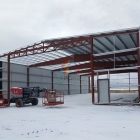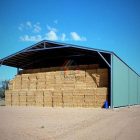Provide livestock shelter solutions for farmers
Protecting livestock is crucial, and choosing a suitable shelter is essential. In this article, we will explore the benefits of steel frame livestock shelters and how to customize them to meet your specific needs.
Why choose steel structure buildings as livestock sheds?
Durability and lifespan
Steel livestock sheds can withstand harsh weather conditions, including wind, snow, and rain resistance. The steel frame and galvanized sheet have excellent strength and durability, ensuring that your shed remains intact for the next few years. In addition, these sheds have low maintenance costs because they are rust and corrosion-resistant.
Customization and flexibility
Steel animal sheds can easily adapt to your needs, whether you need a stable, a small cowshed, or a multifunctional space for multiple animals. As your farm and livestock needs evolve, they can also be expanded or modified in the future.
Cost effectiveness
Compared to traditional wooden structures, steel livestock sheds are an economical choice. Their assembly speed is usually faster, thereby reducing construction costs. In addition, the metal frame and optional insulation materials make these sheds energy-efficient, thereby reducing your operating costs.
Sustainability and ecological friendliness
Steel is a recyclable material used in animal sheds to help reduce its impact on the environment. By choosing steel instead of wood, you can support sustainable practices and minimize deforestation to the greatest extent possible.

Main features of steel animal sheds
The design of steel animal sheds has multiple functions to ensure the safety and comfort of animals. Here are some key features that contribute to its functionality and effectiveness.
Guardrail board
Guardrail boards are an ideal choice for sturdy barriers, preventing animals from escaping shelters and providing a safe environment. The guardrail installed on the lower edge of the wall can protect the structure from damage caused by animal kicking or tilting. These features help create safer and more durable shelters, extending their lifespan.
Hinged doors and pedestrian doors
The hinged door facilitates entry and exit of the shed while ensuring safety. The hinged door can be locked to protect animals from potential threats. Pedestrian gates provide separate entrances for farm workers to ensure the safety of animals and people. These doors can efficiently manage and monitor your livestock.
Ventilation and insulation
Proper ventilation is crucial for maintaining a healthy environment for animals. Steel animal sheds can be designed with adjustable vents, windows, or mesh panels to ensure sufficient air circulation while preventing pests and predators from entering. Steel sheds can also be equipped with insulation materials to protect your animals from the harsh winters in Canada and maintain energy efficiency.

Roof options: pointed roof, peak roof, and transparent roof
Steel animal sheds have various roof options, each with unique advantages. Roof ridges and spires can improve ventilation and promote snow and rain runoff, thereby minimizing the risk of damage or leakage. The roof made of polycarbonate sheet is transparent, allowing light to enter the shed, creating a more comfortable environment for your animals and reducing the need for artificial lighting.
Portable cattle and horse shelters
The portable livestock shelters are designed to be easily moved from one location to another, providing flexibility for managing farm resources. These sheds are perfect for rotational grazing systems, temporary housing needs, or relocating animals to different pastures. These sheds are equipped with functions such as lifting poles, chain links, and receiving pipes, which can be easily transported using farm equipment.
Interior dividers and stalls
Steel cowshed shelters can be designed with internal partitions and enclosures to meet the special needs of livestock. These features allow you to separate animals based on species, age, or health status and provide personalized care. Partitions and enclosures can be made of guardrails, feeder boards, or custom sized doors to ensure a safe and practical space for your animals.
Floor options
Steel animal sheds can be designed with various flooring options to meet your needs. Concrete flooring is durable and easy to clean, while rubber or wooden flooring can provide additional comfort for your animals. In some cases, natural soil flooring may be preferred for good drainage and a more natural environment.
By incorporating these key features into your steel livestock shed, you can create a safe, comfortable, and practical space for your animals. Through proper planning and customization, your shed will contribute to the well-being and productivity of your livestock in the coming years.

Customization options for steel livestock sheds
Small cowshed and stable
The cowshed is designed specifically to meet the needs of young calves, providing protection and comfort. A stable can meet the unique needs of horses, such as higher walls and wider stables.
Feeding board and feed truck
The feeding panel can be integrated into the steel livestock shed for easy feeding of animals. The feed truck is convenient for transporting and distributing feed inside the shed.
Powder coating and galvanized steel
Powder coated steel can provide additional anti-corrosion protection layer, while galvanized steel has excellent rust prevention performance. Both options help extend the lifespan of steel animal sheds and reduce maintenance costs.

Steps to obtain customized steel animal sheds
Assess your needs
Before contacting the manufacturer, please confirm the size and functionality of the livestock shed you require. Consider the number and species of animals you need to raise, as well as any specific requirements such as ventilation, insulation, or feeder panels.
Choose a reputable manufacturer
Choosing a manufacturer ensures that your steel livestock shed complies with local engineering standards and building codes. Looking for a company that enjoys a reputation for quality, customer support, and service.
Design your livestock shelters
Work closely with the manufacturer you choose to create customized designs that meet your specific needs. This may include hinged doors, pedestrian doors, detachable fenders, custom sized doors or partition panels, as well as roof options such as rooftop spires or transparent roofs. Ensure compliance with local building codes and regulations during the design process.
Construction and installation
After the design is completed, prepare the construction site. Arrange the delivery and installation of steel frame animal sheds, ensuring that all necessary permits are in place. The assembly process is usually simple, and manufacturers will provide clear instructions.

Frequently asked questions
What is the typical cost of a steel livestock shed?
The cost varies depending on size, customization, and location. However, compared to wooden alternatives, the construction and maintenance costs of steel shelters are usually lower.
How long does it take to build a steel livestock shed?
The construction time depends on the size and complexity of the shelter, as well as weather conditions. However, the assembly speed of steel structure shelters is usually faster than that of wooden structure shelters.
What is the service life of a steel structure livestock shed?
With proper maintenance and upkeep, steel structure animal sheds can be used for decades.

Conclusion
Steel frame livestock shelters bring many benefits to farmers, as their durability, customization, cost-effectiveness, and sustainability make them an excellent choice for raising livestock. By collaborating with reputable manufacturers, you can create a shed that meets your specific needs and provides a safe and comfortable environment for your animals.
Please remember to assess your needs, plan for future expansion, and explore potential financing opportunities to fully utilize your investment. With carefully designed steel livestock sheds, you can improve the well-being and productivity of farm animals while contributing to a more sustainable future.












